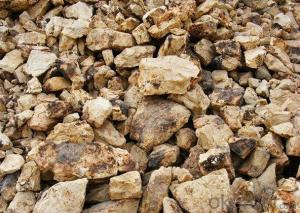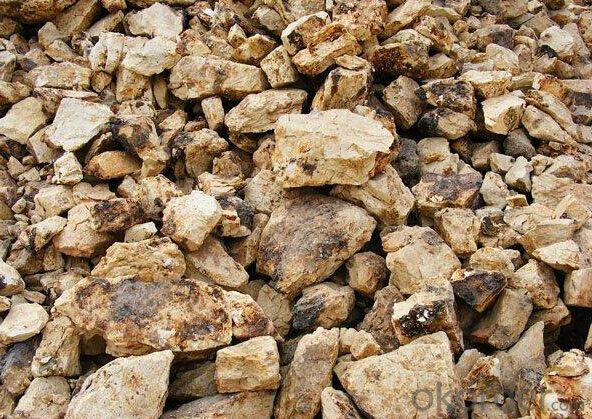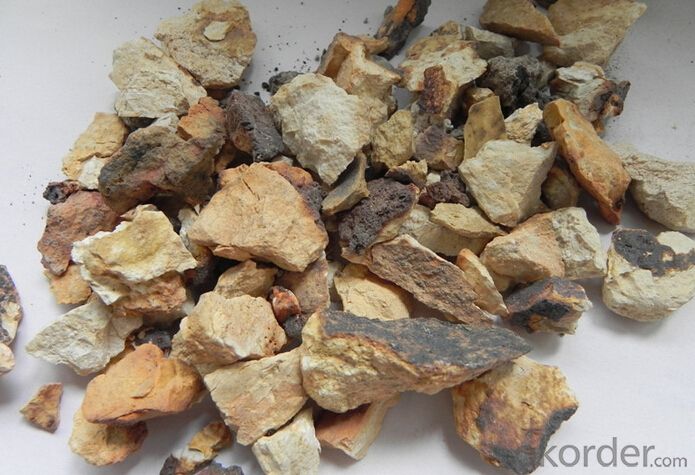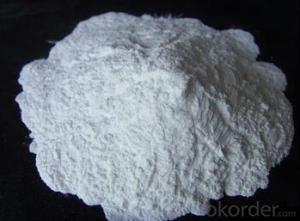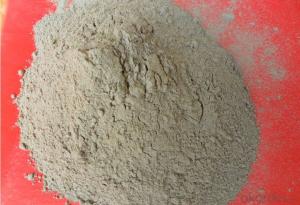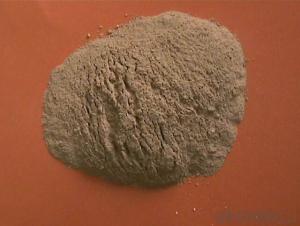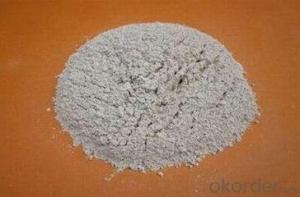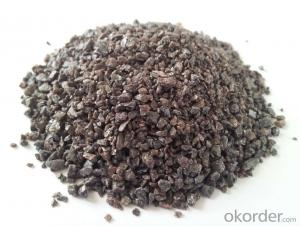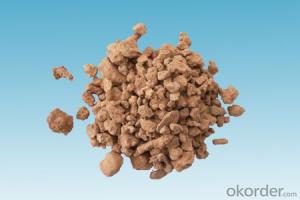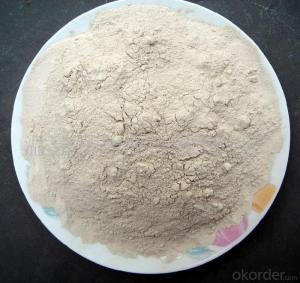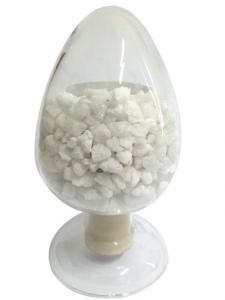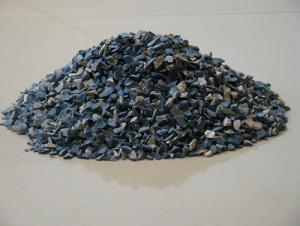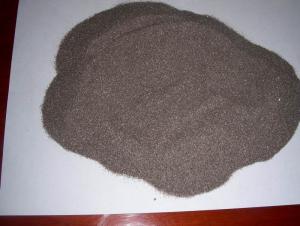Raw Materials for Refractory:Main Features of Calcined Bauxite Popular in USA
- Loading Port:
- Tianjin
- Payment Terms:
- TT OR LC
- Min Order Qty:
- 2000 m.t.
- Supply Capability:
- 10000000 m.t./month
OKorder Service Pledge
OKorder Financial Service
You Might Also Like
1.Structure of Calcined Bauxite Description
Bauxite (aluminous soil; Bauxite) is also called the alumina or bauxite, main ingredients are alumina, hydrated alumina containing impurities, is an earthy mineral. White or gray, brown and yellow or light red by iron.
2.Main Features of the Calcined Bauxite
Calcined bauxite is one of the principal ore of aluminum. Calcined bauxite contains hydrous aluminum oxides and aluminum
hydroxides, formed through the laterization of aluminous rocks in tropical and subtropical areas .Calcined bauxite is obtained by calcining (heating)superior grade bauxite at high temperature (from 85OC to 1600C) .This removes moisture there. By increasing the alumina content,compared to an alumina content of about 57%to 58% in raw bauxite, calcined bauxite has an alumina content of 84%to88%.The heating is carried out in rotary kilns.
3. Calcined Bauxite Images
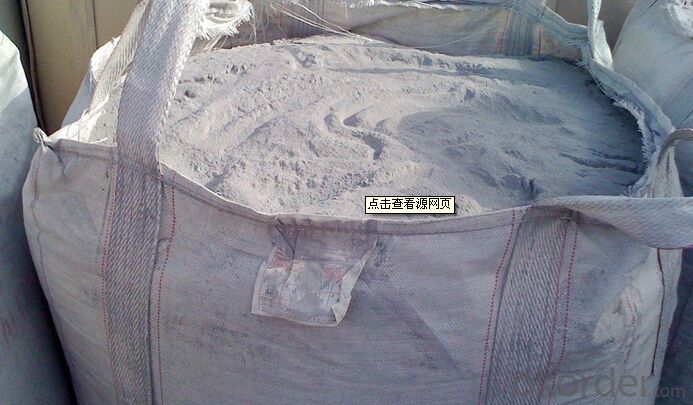

4. Calcined Bauxite Specification
ROTARY KILN BAUXITE
Al2O3 | Fe2O3 | SiO2 | TiO2 | K2O+Na2O | CaO+MgO | B.D (g/ccm) |
min | max | max | max | max | max | min |
88% | 1.8% | 6.5% | 4% | 0.25% | 0.5% | 3.25 |
87% | 2.0% | 7.0% | 4% | 0.25% | 0.5% | 3.15 |
86% | 2.0% | 7.0% | 4% | 0.25% | 0.5% | 3.15/3.10 |
85-80% | 2.0% | 10.0% | 4% | 0.30% | 0.5% | 3.10 |
ROUND KILN BAUXITE
Al2O3 | Fe2O3 | SiO2 | TiO2 | K2O+Na2O | CaO+MgO | B.D (g/ccm) |
min | max | max | max | max | max | min |
88% | 2.0% | 6.5% | 4% | 0.25% | 0.5% | 3.30 |
87% | 2.0% | 6.5% | 4% | 0.25% | 0.5% | 3.25 |
86% | 2.0% | 7.0% | 4% | 0.25% | 0.5% | 3.20 |
85% | 2.5% | 8.0% | 4% | 0.25% | 0.5% | 3.10/3.15 |
5.FAQ of Calcined Bauxite
1). Q: Are you a factory or trading company?
A: We are a factory.
2). Q: Where is your factory located? How can I visit there?
A: Our factory is located in ShanXi, HeNan, China. You are warmly welcomed to visit us!
3). Q: How can I get some samples?
A: Please connect me for samples
4). Q: Can the price be cheaper?
A: Of course, you will be offered a good discount for big amount.
- Q: What's the maximum temperature that the high-temperature resistant refractory ceramic fiber cotton can endure?
- Nichrome wire, stainless steel wire and glass fiber are reinforced. Ceramic fiber coating cloth and slag cloth, sintering ceramic fiber cloth and ceramic fiber fumigation cloth) Characteristics of the ceramic fiber cloth: high temperature resistance, low heat conductivity, thermal shock resistance, low thermal capacity; superior insulating property at high temperature, long service life; resistance to nonferrous metals like molten aluminum and zinc erosion; low and high temperature strength; innocuity with no adverse effect on the environment; Applications of ceramic fiber cloth: It can be applied to the thermal insulation of all kinds of furnaces, high-temperature pipelines and vessels; furnace doors, valves, flange seal, fire doors, fire resisting shutters and high-temperature furnace door curtains; engine and instrument insulation, clad material of fireproof cables, and high-temperature resistant and fire-proof materials; thermal insulation cloth for coverage, high-temperature expansion gap padding, and inner linings of the flue; high temperature resistant labor safety products, fireproof suits, high-temperature filtration and sound absorption, replacement of asbestos, etc.
- Q: The mechanism and function of antioxidants in carbon containing composite refractories are briefly described.
- Mechanism analysis of silicon actionWhen silica fume is added to the carbon composite refractory, the phase changes and chemical changes are as follows:<1> Si (s) +C (s) =SiC (s) Delta G ~ =-522+1.50T (kJ)<2> Si (s) +MgO (s) =Si (g) +Mg (g) Delta G ~ =203.9-0.13T (kJ)<3> 2Si (s) +CO (g) =SiC (s) +SiO (g) Delta G ~ =-963.2+0.31T (kJ)<4> SiC (s) +CO (g) =SiO (g) +2C (s) Delta G ~ =81.47-0.15T (kJ)<5> SiO (g) +CO (g) =SiO2 (s) +C (s) Delta G ~ =-668.8+0.33T (kJ)From the above diagram and the reactions seen at high temperatures has joined the Si SiO and Mg volatiles, but <4> and <5> reaction have played a role in inhibiting carbon oxidation, and the condensation of SiO2 to a certain extent the role of protective film.The total reaction process is CO reduction to C, and there is a certain volume expansion, so that the pores are blocked and the density of bricks is increased. Therefore, the oxidation resistance of brick is improved.
- Q: I wanna ask about the building insulation materials fire rating?
- Hello, I am happy to answer your questions about the classification of building insulation materials fire rating: 1. The thermal insulation material of level A combustion performance: Rock wool, glass wool, foam glass, foamed ceramics, foam cement, hole-closed perlite, etc. 2. combustion performance is level B1 insulation materials: Extruded polystyrene board (XPS) after special treatment / Special treatment of polyurethane (PU), phenolic aldehyde and gelatine powder polyphenyl granule 3 combustion performance is level B2 insulation material: Molding polystyrene board (EPS), extruded polystyrene board (XPS), polyurethane (PU), polyethylene (PE), etc. I hope I can help you
- Q: How many refractory materials does the annual output of 1 million tons of coke oven require?
- Refractory materials are expensive, and any refractory accident will lead to a considerable waste of production time and equipment, and sometimes even the product itself. The type of refractory material will also affect energy consumption and product quality. Therefore, it is very important to select the refractory material which is most suitable for various applications. While the economic benefits have great influence, refractory material most suitable for some applications need not be used for materials, but can achieve a balance between material installation cost and performance, this balance is not fixed, but with the introduction of new technology or new refractory materials and changing. History has proved that unremittingly seek metallurgical process more reasonable and development, greatly promoted the development of refractories, quickly resolve these problems has become the modern refractory steel technology development is an important element. The content of this article is to discuss a number of factors including these issues and to provide information on how to solve them.
- Q: What are the chemical composition of refractory cement?
- Calcium aluminate prepared by calcining as the main component. Aluminate cement takes bauxite and limestone as raw materials, alumina content of about 50% as the clinker. And it is a hydraulic cementing material made by grinding. Refractory cement is also known as aluminate cement.
- Q: What is the definition and classification of amorphous fire resistance materials?
- 9.8. brick made of refractory bone material and powder material can be used directly or after adding appropriate liquid formulation Refractory paint. Refractory slinging material 6. Prefabricated cubes, bonding agent or other additives. fire-resistance sparying material compround additives. Refractory pressed into the material, binder. Refractory ramming material 3, The material is a new fire proof material without calcination Heavy aggregate and lightweight aggregate: Inorganic binding agent and organic bond, its fire resistance is not less than 1580. Refractory castables 2 mouldable refractory Classification according to the type of bonding agent: 1. Classification according to refractory aggregate. According to the production and construction method, refractory mud or refractory mire, with a certain proportion of the mixture
- Q: What is the difference between the fire?rating and the fire resistant level of the fire-fighting equipment?
- Fire rating and fire-fighting rating are the misnomer to the building fire resistant level. The building fire risk is measured by fire resistant level. The article 3.2.1 and 5.1.7 of "Architectural design code for fire protection" have made provision respectively on the fire resistant level of plant (the storeroom) and civil construction. Article 3.0.2 of "Code for fire protection design of tall buildings" has made provisions on the fire resistant level of tall buildings. Fire resistance rating of the building is divided into four levels. Standard of fire resistance rating is determined by the combustion performance and fire resistance of the main housing member. Level one or two are in accordance with the Article 1.0.2 in this specification.
- Q: Fefractory of aluminium oxide.
- Do you mean the alumina hollow ball brick? We can exchange private messages in specific.
- Q: How many levels are there in the classification of PP fireproof materials?
- PP fireproof materials level V-0: After two 10-second fame tests on the sample, the flame extinguishes within 30 seconds. Inflamer can not drop. V-1: After two 10-second flame tests on the sample, the flame extinguishes within 60 seconds. Inflamer can not drop. V-2: After two 10-second flame tests on the sample, the flame extinguishes within 60 seconds. Inflamer can drop.
- Q: Who knows the fire endurance of rock wool color plate?
- Colored steel rock wool board is used for areas with high fireproofing requirements. Colored steel rock wool board belongs to class A according to "Fireproof? Specification of Building Interior Decoration?Design" whose lifetime can reach more than 15 years, operating temperature can up to about 700 ℃, maximum fireproofing time is 6 hours. And rock wool colored plate is environmentally friendly materials, which is is the preferred material in the construction industry .
Send your message to us
Raw Materials for Refractory:Main Features of Calcined Bauxite Popular in USA
- Loading Port:
- Tianjin
- Payment Terms:
- TT OR LC
- Min Order Qty:
- 2000 m.t.
- Supply Capability:
- 10000000 m.t./month
OKorder Service Pledge
OKorder Financial Service
Similar products
Hot products
Hot Searches
Related keywords
